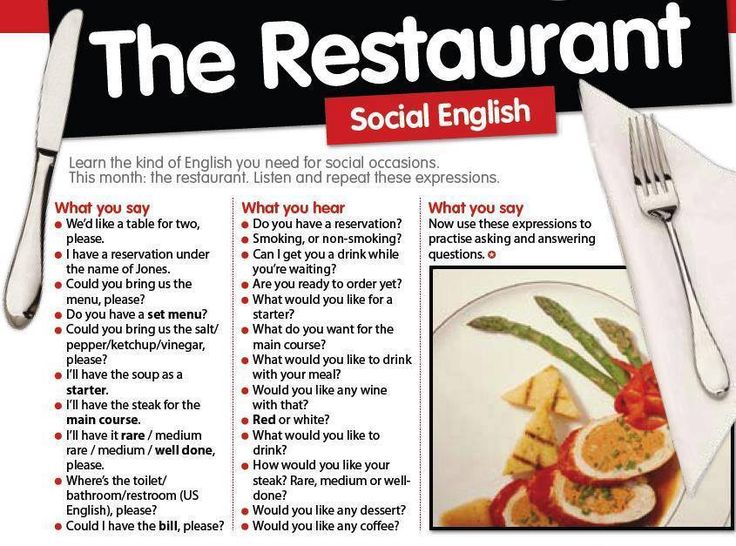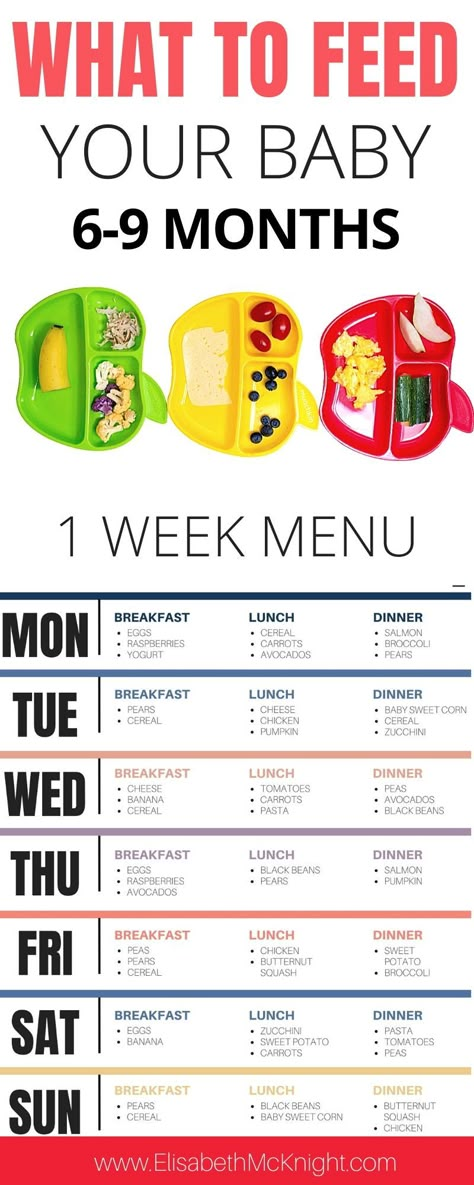Order of first foods for baby
Do's and Don'ts for Baby's First Foods
Breastfeeding has been shown to improve infant, child and maternal health outcomes and help control healthcare costs, but how long should breastfeeding last and when should parents introduce solid foods?
The Dietary Guidelines for Americans recommend exclusive breastfeeding, meaning the infant receives only breast milk, during the first six months of life for optimal nutrition and health benefits.
Once solid foods are introduced, health professionals recommend continuing breastfeeding through 12 months of age and, after that, as desired by mother and baby. Introducing your baby to solid foods is an exciting milestone. When you start introducing children to the world of solid foods, you are helping them shape their relationship with food and establish a healthy eating style. The timing for introducing solid foods will depend on the infant, but it is not recommended before the age of four months or after the age of six months.
Not sure how to get your baby started on solid foods? Consider these helpful tips.
Is Your Baby Ready to Transition?
Each child's readiness for solid food depends on their own rate of development. Signs a baby may be ready to start solid foods include sitting up with minimal support, demonstrating good head control, bringing objects to the mouth or grasping at small objects. Check with your pediatrician before starting solid foods.
Getting Started With Solids
Solid foods may be introduced in any order. However, puréed meats, poultry, beans and iron-fortified cereals are recommended as first foods, especially if your baby has been primarily breastfed, since they provide key nutrients. Only one new single-ingredient food should be introduced at a time.
Softer textures are very important when first introducing foods. Infants usually start with pureed or mashed foods around six months. As infants develop chewing and motor skills, they are able to handle items like soft pieces of fruit and finger foods. As the child ages, a variety of healthful foods is encouraged.
As the child ages, a variety of healthful foods is encouraged.
Weaning From Breastfeeding
When deciding if you should wean your baby to a bottle or a cup, consider their developmental readiness. Between 7 and 8 months, most infants will drink small amounts of liquid from a cup or a glass when someone else holds it. Older babies and toddlers often have the coordination to drink fluids from a cup by themselves.
If your baby is under 12 months of age and you are not continuing to breastfeed, wean from breast milk to iron-fortified infant formula. If your baby is 12 months or older, whole cow’s milk is appropriate.
Food Safety Do’s and Don’ts
Food safety concerns for infants and toddlers include food allergies, choking and risks for foodborne illness. Keep the following safety tips in mind:
Do talk with your pediatrician about the risk of food allergies. Introducing one new food at a time, every several days, allows time to monitor for allergic reactions.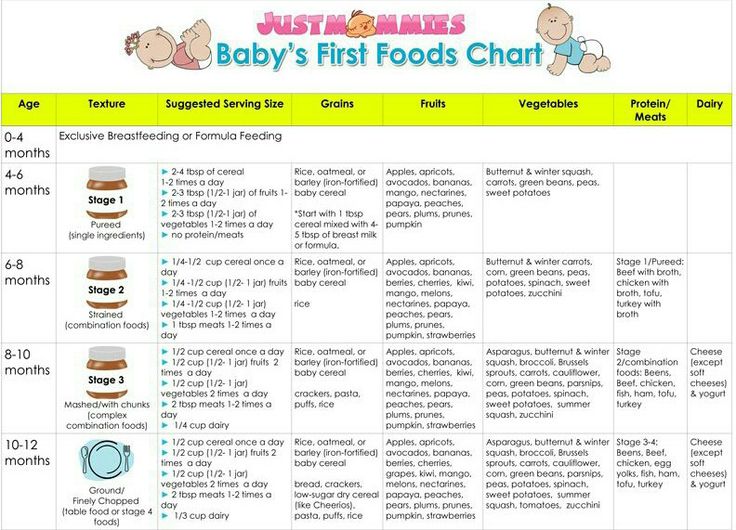 Current evidence does not indicate needing to wait beyond 4 to 6 months before introducing potential allergy-causing foods such as eggs, dairy, soy, peanuts and fish. In fact, introducing peanut-containing foods as early as 4 to 6 months of age may help prevent a peanut allergy. The Dietary Guidelines for Americans recommends introducing potentially allergenic foods when other complementary foods are introduced to an infant’s diet. Parents with concerns about food allergies should discuss how to include these foods with their pediatrician.
Current evidence does not indicate needing to wait beyond 4 to 6 months before introducing potential allergy-causing foods such as eggs, dairy, soy, peanuts and fish. In fact, introducing peanut-containing foods as early as 4 to 6 months of age may help prevent a peanut allergy. The Dietary Guidelines for Americans recommends introducing potentially allergenic foods when other complementary foods are introduced to an infant’s diet. Parents with concerns about food allergies should discuss how to include these foods with their pediatrician.
Don’t feed your baby solid foods from a bottle. It can be a choking hazard and despite a popular misconception, putting cereal in a baby's bottle won't help with sleeping through the night. Other foods that are considered to be choking hazards are listed below.
Do supervise your child while eating. Infants should be able to sit upright and face forward when you first introduce solid foods. This makes swallowing easier and choking less likely.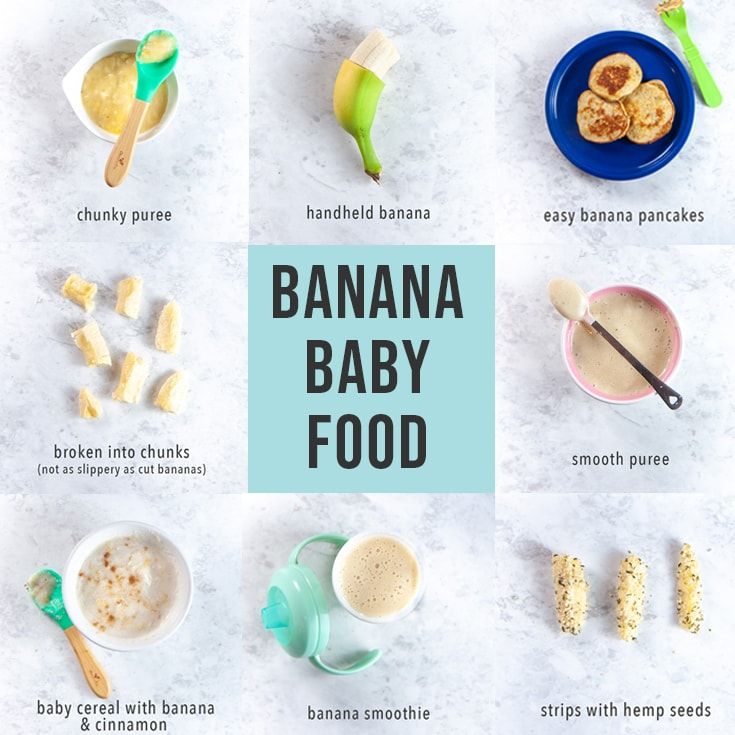
Don’t feed directly from the jar of food but instead spoon some food into a separate dish first. Feeding directly from the jar may introduce bacteria from your baby's mouth to the spoon and back into the food, creating a food safety issue.
Don’t feed honey to children under 12 months of age due to the risk of foodborne illness.
Examples of appropriate solid foods listed by age:
6 months:
- Well-cooked and pureed meat, poultry or beans
- Ground, cooked, single-grain cereal or infant cereal with breast milk or formula
- Cooked and pureed vegetables
- Mashed banana or avocado
9 months:
- Well-cooked, minced or finely chopped meat, poultry or beans
- A variety of cooked vegetables cut into small, ½ inch pieces, such as squash and green beans
- Sliced and quartered bananas or small pieces of other soft fruits
12 months:
- Soft, shredded meat, poultry or fish
- Small pieces of cooked vegetables
- Small pieces of soft, easy to chew fruits
- Mixed food dishes the family is eating in appropriately sized pieces
Not recommended for those under 4 years of age due to the risk of choking:
- Popcorn and whole kernel corn
- Nuts and seeds
- Large chunks of meat, poultry and cheese
- Candy, gum drops and jelly beans
- Hard, raw fruits or vegetables such as apples, celery and carrots
- Whole grapes and cherry tomatoes, unless cut into quarters
- Hot dogs, unless cut into strips and age appropriate, bite-size pieces
- Sticky foods, such as peanut butter, which can get stuck in the back of the mouth – peanut butter is okay if spread thinly on bread
For toddlers and preschoolers, chop grapes, meat, poultry, hot dogs and raw vegetables and fruits into small pieces (about ½ inch or smaller).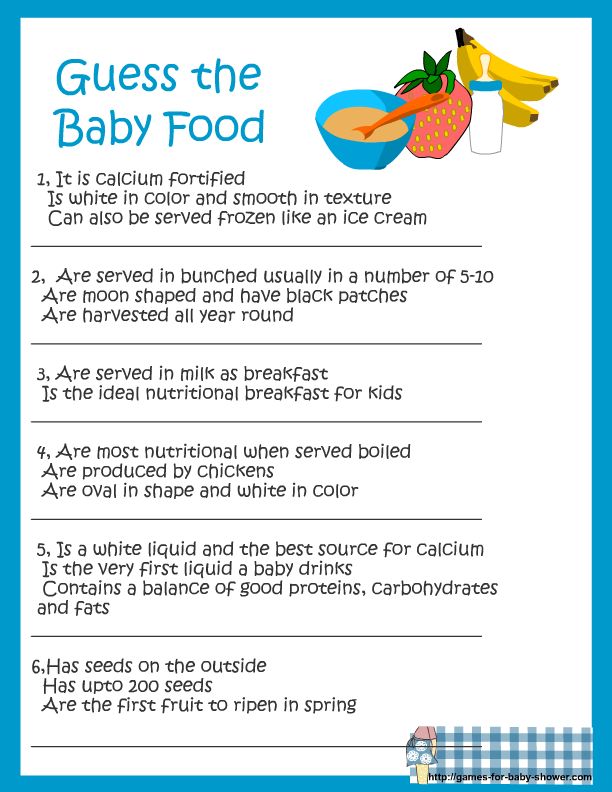
Nurturing Healthy Relationships with Food
Establishing a positive feeding relationship during infancy can have lifetime benefits. Keep in mind that children are responsible for how much and whether they eat so always wait for your baby to pay attention to each spoonful before you feed them. Don't be afraid to let your baby touch the food in the dish and on the spoon. You wouldn't want to eat something if you didn't know anything about it, would you? In addition, know the cues that your baby is done eating. A common cue babies are full is head turning.
Whatever happens, don't get discouraged and enjoy the experience. With a little patience and creativity, you can make your baby's first solid food eating experience fun for everyone involved!
Tags
Find a Nutrition Expert
Looking for credible nutrition information and recommendations? The Academy of Nutrition and Dietetics' network of credentialed food and nutrition practitioners are ready to help!
See Directory
When, What, and How to Introduce Solid Foods | Nutrition
For more information about how to know if your baby is ready to starting eating foods, what first foods to offer, and what to expect, watch these videos from 1,000 Days.
The Dietary Guidelines for Americans and the American Academy of Pediatrics recommend children be introduced to foods other than breast milk or infant formula when they are about 6 months old. Introducing foods before 4 months old is not recommended. Every child is different. How do you know if your child is ready for foods other than breast milk or infant formula? You can look for these signs that your child is developmentally ready.
Your child:
- Sits up alone or with support.
- Is able to control head and neck.
- Opens the mouth when food is offered.
- Swallows food rather than pushes it back out onto the chin.
- Brings objects to the mouth.
- Tries to grasp small objects, such as toys or food.
- Transfers food from the front to the back of the tongue to swallow.
What Foods Should I Introduce to My Child First?
The American Academy of Pediatrics says that for most children, you do not need to give foods in a certain order. Your child can begin eating solid foods at about 6 months old. By the time he or she is 7 or 8 months old, your child can eat a variety of foods from different food groups. These foods include infant cereals, meat or other proteins, fruits, vegetables, grains, yogurts and cheeses, and more.
Your child can begin eating solid foods at about 6 months old. By the time he or she is 7 or 8 months old, your child can eat a variety of foods from different food groups. These foods include infant cereals, meat or other proteins, fruits, vegetables, grains, yogurts and cheeses, and more.
If your child is eating infant cereals, it is important to offer a variety of fortifiedalert icon infant cereals such as oat, barley, and multi-grain instead of only rice cereal. Only providing infant rice cereal is not recommended by the Food and Drug Administration because there is a risk for children to be exposed to arsenic. Visit the U.S. Food & Drug Administrationexternal icon to learn more.
How Should I Introduce My Child to Foods?
Your child needs certain vitamins and minerals to grow healthy and strong.
Now that your child is starting to eat food, be sure to choose foods that give your child all the vitamins and minerals they need.
Click here to learn more about some of these vitamins & minerals.
Let your child try one single-ingredient food at a time at first. This helps you see if your child has any problems with that food, such as food allergies. Wait 3 to 5 days between each new food. Before you know it, your child will be on his or her way to eating and enjoying lots of new foods.
Introduce potentially allergenic foods when other foods are introduced.
Potentially allergenic foods include cow’s milk products, eggs, fish, shellfish, tree nuts, peanuts, wheat, soy, and sesame. Drinking cow’s milk or fortified soy beverages is not recommended until your child is older than 12 months, but other cow’s milk products, such as yogurt, can be introduced before 12 months. If your child has severe eczema and/or egg allergy, talk with your child’s doctor or nurse about when and how to safely introduce foods with peanuts.
How Should I Prepare Food for My Child to Eat?
At first, it’s easier for your child to eat foods that are mashed, pureed, or strained and very smooth in texture. It can take time for your child to adjust to new food textures. Your child might cough, gag, or spit up. As your baby’s oral skills develop, thicker and lumpier foods can be introduced.
It can take time for your child to adjust to new food textures. Your child might cough, gag, or spit up. As your baby’s oral skills develop, thicker and lumpier foods can be introduced.
Some foods are potential choking hazards, so it is important to feed your child foods that are the right texture for his or her development. To help prevent choking, prepare foods that can be easily dissolved with saliva and do not require chewing. Feed small portions and encourage your baby to eat slowly. Always watch your child while he or she is eating.
Here are some tips for preparing foods:
- Mix cereals and mashed cooked grains with breast milk, formula, or water to make it smooth and easy for your baby to swallow.
- Mash or puree vegetables, fruits and other foods until they are smooth.
- Hard fruits and vegetables, like apples and carrots, usually need to be cooked so they can be easily mashed or pureed.
- Cook food until it is soft enough to easily mash with a fork.

- Remove all fat, skin, and bones from poultry, meat, and fish, before cooking.
- Remove seeds and hard pits from fruit, and then cut the fruit into small pieces.
- Cut soft food into small pieces or thin slices.
- Cut cylindrical foods like hot dogs, sausage and string cheese into short thin strips instead of round pieces that could get stuck in the airway.
- Cut small spherical foods like grapes, cherries, berries and tomatoes into small pieces.
- Cook and finely grind or mash whole-grain kernels of wheat, barley, rice, and other grains.
Learn more about potential choking hazards and how to prevent your child from choking.
Top of Page
Detailed list of all foods for the first 90 days of introduction of complementary foods for a child.
Download the table of complementary foods in PDF format:
- Zucchini. Zucchini puree contains only 24 kcal per 100 grams of finished product. Proteins -0.
 6; fat - 0.3; carbohydrates - 4.6. Contains calcium, magnesium, vitamins A, C, B6 and iron. To save vitamins, we will prepare the first puree for a child for a couple. Zucchini cooks quickly, 10 minutes is enough. The first serving is 5 grams (a teaspoon), even less, at the tip of a spoon. We'll give you a taste of the new flavor. Take a small circle of zucchini (we choose the smallest, youngest baby zucchini, the puree will be sweet), wash well (you don’t need to clean and remove the seeds from young zucchini), cook for 10 minutes for a couple and grind through a sieve. Let the child try. The feeding temperature should be around 40 degrees. DEFINITELY try the puree yourself before giving it to a child! Not bitter, not sour, are there any strange aftertastes that may indicate a poor quality vegetable? We offer zucchini for 5-7 days according to the scheme: 5 grams - 10 grams - 20 - 40 - 60 - 60 - 60. The zucchini has passed the test! Let's put it aside for now and move on to the next product.
6; fat - 0.3; carbohydrates - 4.6. Contains calcium, magnesium, vitamins A, C, B6 and iron. To save vitamins, we will prepare the first puree for a child for a couple. Zucchini cooks quickly, 10 minutes is enough. The first serving is 5 grams (a teaspoon), even less, at the tip of a spoon. We'll give you a taste of the new flavor. Take a small circle of zucchini (we choose the smallest, youngest baby zucchini, the puree will be sweet), wash well (you don’t need to clean and remove the seeds from young zucchini), cook for 10 minutes for a couple and grind through a sieve. Let the child try. The feeding temperature should be around 40 degrees. DEFINITELY try the puree yourself before giving it to a child! Not bitter, not sour, are there any strange aftertastes that may indicate a poor quality vegetable? We offer zucchini for 5-7 days according to the scheme: 5 grams - 10 grams - 20 - 40 - 60 - 60 - 60. The zucchini has passed the test! Let's put it aside for now and move on to the next product.
- Cauliflower. Cauliflower puree contains 33 kcal per 100 grams of finished product. Proteins, fats and carbohydrates, respectively: 1.6 / 0.7 / 5.4. Contains calcium, magnesium, iron, vitamins C and B6. To save vitamins, we cook for a couple. We divide the cabbage into small inflorescences, cook for 15 minutes. Grind the first portion (5 grams) on a sieve, prepare large portions with an immersion blender with the addition of boiled baby water, so that the consistency is the same as that of the zucchini. Cabbage, unlike zucchini, contains less water, so it needs to be added. We give according to the scheme: 5-10-20-40-60-60-60. Recall that it is not necessary to give all 7 days, five days will be enough to test for allergens.
- Broccoli. For 100 grams of finished puree 34 kcal. Proteins 2.8; Fats 0.4; Carbohydrates 6.6. Broccoli contains a lot of vitamin A, as well as calcium, magnesium, iron and vitamin C. We prepare mashed potatoes according to the same principle as cauliflower.
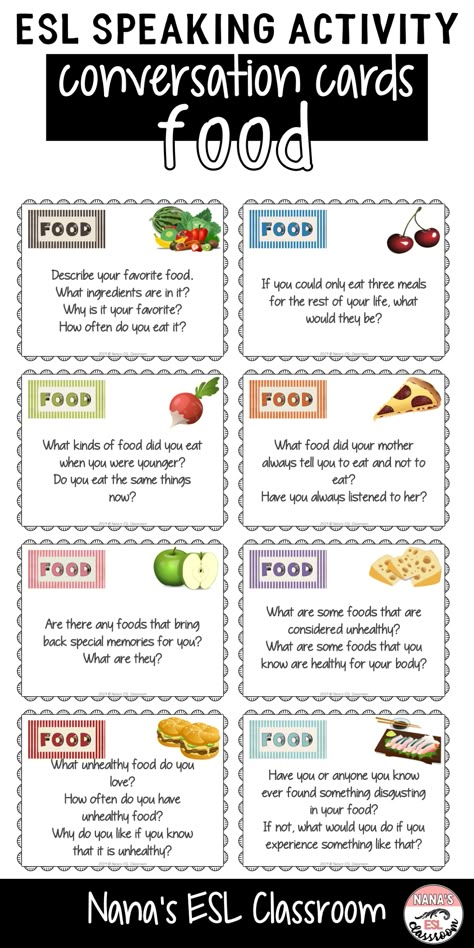
- Buckwheat porridge. From vegetables to cereals. It's time to try the cereals. Previously, it was recommended that babies start complementary foods with cereals if they are not gaining weight well, or start complementary foods before six months. But it's all MYTH! Well, the baby will not start gaining better if instead of a portion of fatty milk he receives 60 grams of lean porridge cooked in water. Yes Yes! The first cereals are dairy-free, sugar-free and gluten-free! It is important! For the first test, it is still recommended to introduce special baby cereals, which are sold in stores. Why? Because cereals for children's cereals are not treated with rodenticides, unlike ordinary cereals on store shelves. Yes, and making flour from ordinary buckwheat and cooking 5 grams of such porridge will not be so easy as pouring half a teaspoon of prepared store-bought baby porridge with water, stir and give to the baby. Therefore, we suggest buying a pack of special children's dairy-free buckwheat for the first try and cook it according to the cooking method indicated on the package.

- Rice porridge. Same as buckwheat: dairy-free, gluten-free, salt-free and sugar-free. We look at the energy value on the packaging.
- Corn porridge. This porridge is the most high-calorie of the three, so it is still better to introduce it as the third one. The scheme is still the same as with vegetables: 5-10-20-40-60-60-60 (the last two days are optional). When the volume of any of the cereals reaches 40 and 60 grams, you can add a little already introduced vegetables to it (also up to 40 grams), so that the porridge is not too viscous and monotonous for the child (“in a dry bag”, as we usually say).
- Pumpkin. Puree and pumpkin will already contain 88 kcal per 100 grams of the finished product. Thus, we gradually raise the calorie content of products. Proteins / fats / carbohydrates - 1.7 / 6.2 / 6.3. We clean and cut it into cubes, steam the pumpkin, about 15 minutes. Puree is introduced as before 5-10-20-40-60-60-60.
 For portions of 40 and 60 grams, you can try to give it together with the already tested porridge and bring the total volume up to 100 grams.
For portions of 40 and 60 grams, you can try to give it together with the already tested porridge and bring the total volume up to 100 grams. - Apple. It's time to taste fruit. Why weren't they introduced earlier? Because, from birth, a child has a love for sweets, and if you start complementary foods with fruits, then there is a high probability that you will eat vegetables yourself later. We start complementary foods from the most tasteless foods incrementally. The finished puree contains 85 kcal per 100 grams of the finished product. How to cook: wash, peel, cut apples and send to a double boiler or cook in boiling water for 10 minutes (a couple more vitamins will be preserved). Scheme 5-10-20-40-60-60-60. By the way, with regard to fruits, a dose of 60, maximum 80 grams for a child up to a year is quite sufficient. If we then increase the portions of vegetables and cereals, then we will leave the fruits. A large amount of sugar is not good for a child. Up to 40 grams we give applesauce as a separate dish, from 40 grams and more we mix with cereals.
 Now we will gradually increase the volume and replace breakfast with porridge with fruit, seasoned with a small amount of butter (at the rate of 2 grams of butter per 100 grams of porridge).
Now we will gradually increase the volume and replace breakfast with porridge with fruit, seasoned with a small amount of butter (at the rate of 2 grams of butter per 100 grams of porridge). - Rabbit. It's time to introduce meat! At this point, the baby should be about 8 months old. It is recommended to start with a rabbit, as this is the most dietary meat. How to cook: we twist the meat in a meat grinder, form small meatballs and weld them a little in boiling water. It’s good if you have a kitchen scale at home and you can immediately prepare meatballs for the required 5-10-20-40 and 50 grams. We throw the boiled meatballs into a colander so that the glass is excess water and they cool, then we freeze. Our semi-finished product is ready! The first 5 and 10 grams are given separately. Boil or steam again and grind with a blender. Starting from 20 grams, grind together with the introduced vegetables. Now you can gradually increase the portions and replace lunch with vegetables and meat seasoned with a small amount of vegetable oil (at the rate of 1 teaspoon per 100 grams of vegetables).
 Meat, unlike all other products that are necessarily introduced in the first half of the day, is introduced at lunchtime.
Meat, unlike all other products that are necessarily introduced in the first half of the day, is introduced at lunchtime. - Prunes. We prepare mashed potatoes in the same way as from apples, but first, prunes need to be washed, peeled and soaked for a couple of hours in water, then steamed and chopped with a blender. Portions are the same as for an apple: 5-10-20-40-60-60-60. Starting from 40 grams, mix with porridge.
- Turkey. We choose the fillet and give it according to the principle of the rabbit.
- Pear, banana, apricot, peach, plum. We introduce these fruits one by one according to the same principle as we introduced apple and prunes.
So, we have sorted out the safest products for the baby! Selected according to our climate, according to their energy value, composition and vitamin content. To put together a correct balanced diet, you need to know some WHO (World Health Organization) recommendations for complementary foods:
- At 6-8 months, the child should receive 60% kcal from breast milk and 40% kcal per day from complementary foods ;
- At 9-11 months, the baby should receive 45% kcal from breast milk and already 55% kcal per day from complementary foods ;
- The volume of the baby's stomach is approximately equal to 30 ml/kg of the baby's weight;
- At 6-8 months, smoothly go to 2 meals based on complementary foods (breakfast and lunch) and the minimum energy density of the meal should be 0.
 9 kcal / g for breastfeeding or 1.7 kcal / g for artificial feeding;
9 kcal / g for breastfeeding or 1.7 kcal / g for artificial feeding; - Protein requirements for babies 6-9months 1.25 g/kg body weight;
- Fat should make up 30-40% of the daily calorie intake of the entire diet.
Download the food table in PDF format:
Maria Fadeeva
Pediatrician GMS Clinic
“My baby is 4 months old, and until that time I didn’t think that he might need something else besides mother’s milk,” says 25-year-old Irina. “But it seems it’s time to introduce complementary foods, and our pediatrician advises not to delay. And I understand that I don’t know enough about all this, and I’m a little confused. What to give? How? How much? There are more questions than answers. "
Today we are talking about all the nuances of introducing complementary foods with GMS Clinic pediatrician Fadeeva Maria Vladimirovna.
The first year of a child's life is a busy and at the same time difficult period for both the baby and the parents. In no other time period throughout life does the human body undergo such significant changes as in the first 12 months after birth. All organs and systems continue to "ripen" and adapt to the existence in the external environment. It is very important at this moment not to disturb the delicate balance and natural mechanisms of adaptation, so the parents' concern about the start of the introduction of complementary foods is completely justified.
In no other time period throughout life does the human body undergo such significant changes as in the first 12 months after birth. All organs and systems continue to "ripen" and adapt to the existence in the external environment. It is very important at this moment not to disturb the delicate balance and natural mechanisms of adaptation, so the parents' concern about the start of the introduction of complementary foods is completely justified.
What is complementary foods
Complementary foods include all products, except breast milk and infant formula, which supplement the diet with substances necessary for the further growth and development of the child.
In the first months of life, the baby has enough milk, but over time, the diet should become more varied, gradually replacing breast milk or formula. The older the child gets, the more space occupies complementary foods in the overall pattern of food intake.
When to start complementary foods
The stomach and intestines of a newborn baby are adapted only for the assimilation of breast milk and its substitutes. In babies, there is a so-called spoon ejection reflex: up to 3-4 months, any solid food that enters the mouth and throat is pushed back. Thus, nature protects the baby from asphyxia and problems with irritation of the walls of the gastrointestinal tract with inappropriate food. This reflex normally gradually fades away by the end of the 4th month of life.
In babies, there is a so-called spoon ejection reflex: up to 3-4 months, any solid food that enters the mouth and throat is pushed back. Thus, nature protects the baby from asphyxia and problems with irritation of the walls of the gastrointestinal tract with inappropriate food. This reflex normally gradually fades away by the end of the 4th month of life.
Around this age, the gastrointestinal tract and the local immune system of the intestine "ripen", which reduces the risk of allergic reactions when new products are introduced.
If the baby is healthy, it is recommended to start complementary foods between 4 and 6 months of age.
Introduction of complementary foods after 6 months entails the risk of nutritional deficiencies, slower development of chewing and swallowing skills of solid foods, as well as a greater food load due to the desire to introduce "everything at once".
In addition to age, there are signs by which you can determine that it is time for a child to introduce complementary foods: the baby sits with support or independently, holds his head well and shows interest in food.
What foods to start with
In our country, the first complementary foods are vegetable purees or cereals. The choice of product depends on the characteristics of a particular child. For example, we offer vegetables first in case of constipation or overweight in a baby, cereals in case of insufficient weight gain. In any case, when planning the introduction of complementary foods, consult your pediatrician.
How much to start and when to add complementary foods
For the first time, a small amount (eg 1/2-1 tsp) is enough. Then we observe the tolerance of the new food by the child, if there is no allergic reaction, we gradually increase the volume of the product over the course of a week to the recommended one at this age. After that, you can get acquainted with another dish.
Over time, the amount of food increases in proportion to the weight of the child and his request. At the same time, you should not set yourself the task of minimizing the consumption of breast milk / infant formula, as they still remain for the baby a source of nutrients necessary for full development.
Are there any peculiarities of introducing vegetables and fruits into the diet?
For the first experiments, you can choose, for example, broccoli, zucchini, carrots, pumpkin, potatoes, etc. Sometimes a child may not like a new product the first time. But do not be upset! Sometimes it takes up to 10-15 attempts to accept a new one.
Introducing fruits We also start with a single-component puree, such as apple, pear, plum, etc. Fruit complementary foods are especially relevant if the baby has constipation.
How to start feeding with meat correctly
Meat is introduced from 6 months. The timely inclusion of meat puree in the diet is important, since it is a source of easily digestible iron. We are starting to offer various options for meat puree also separately, for example, puree from chicken, turkey, rabbit, beef, pork, etc.
If your baby is allergic to cow's milk protein, the pediatrician may recommend postponing the introduction of beef until later, but other types of meat are allowed.
When to Defer Complementary Feeding
General recommendations for introducing complementary foods are for healthy children. However, questions about the introduction and scheme of complementary foods are always resolved individually with the pediatrician observing the child.
Do not introduce complementary foods during an acute period of infectious diseases, at the time of a family move or vacation, and for 3 days before and after vaccination.
How to track your baby's response to complementary foods
A baby's food allergy can present with two sets of symptoms. After introducing a new product, carefully observe its condition.
If during or after eating a child develops a rash, red spots on the skin, cough, pallor and difficulty breathing, swollen lips or face, then in such a situation it is necessary to stop feeding this product and seek medical help.
The second group of symptoms of food intolerance - digestive disorders in the form of profuse regurgitation, vomiting, loose stools.
In order to notice negative manifestations in time, it is better to try new things in the first half of the day and do not forget that you need to gradually increase the amount of food. It takes 5-7 days for the baby to get used to the product, only after that you can give a new one.
What else parents should know before starting complementary foods
There are a few more tips that will allow you to organize complementary foods correctly, comfortably and safely:
- Never force feed your baby.
- Be sure to offer bottled baby water from the start of complementary foods.
- Do not give food using gadgets, they not only affect the formation of food hygiene, but also adversely affect the eyes and nervous system.
- Complementary foods are best offered before breast milk/formula feeding.
- We start with pureed food. Pieces will be required, but later. During the start of complementary foods, this is dangerous: the child can easily choke and suffocate.
